An Analysis of Sanctioning Strategies in Environmental Protection
VerifiedAdded on 2020/01/06
|13
|4440
|257
Report
AI Summary
This report delves into the critical topic of sanctioning strategies within the realm of environmental protection. It begins by establishing the significance of environmental protection in the face of increasing environmental crime, emphasizing the need for governmental and individual efforts to curb exploitation. The report then provides a comprehensive overview of environmental crime, its various forms, and its detrimental impact on the environment and human health. It examines the meaning and importance of environmental protection, highlighting the influence of environmental legislation, ethics, and education. The core of the report focuses on three primary sanctioning approaches: civil, administrative, and criminal. Each approach is examined in detail, outlining its key elements, advantages, and limitations. The report concludes by advocating for the criminal sanctioning approach as a potentially more effective method for deterring environmental crimes. It underscores the flexibility and adaptability of this approach, making it suitable for addressing a wide range of environmental offenses and ensuring environmental protection.
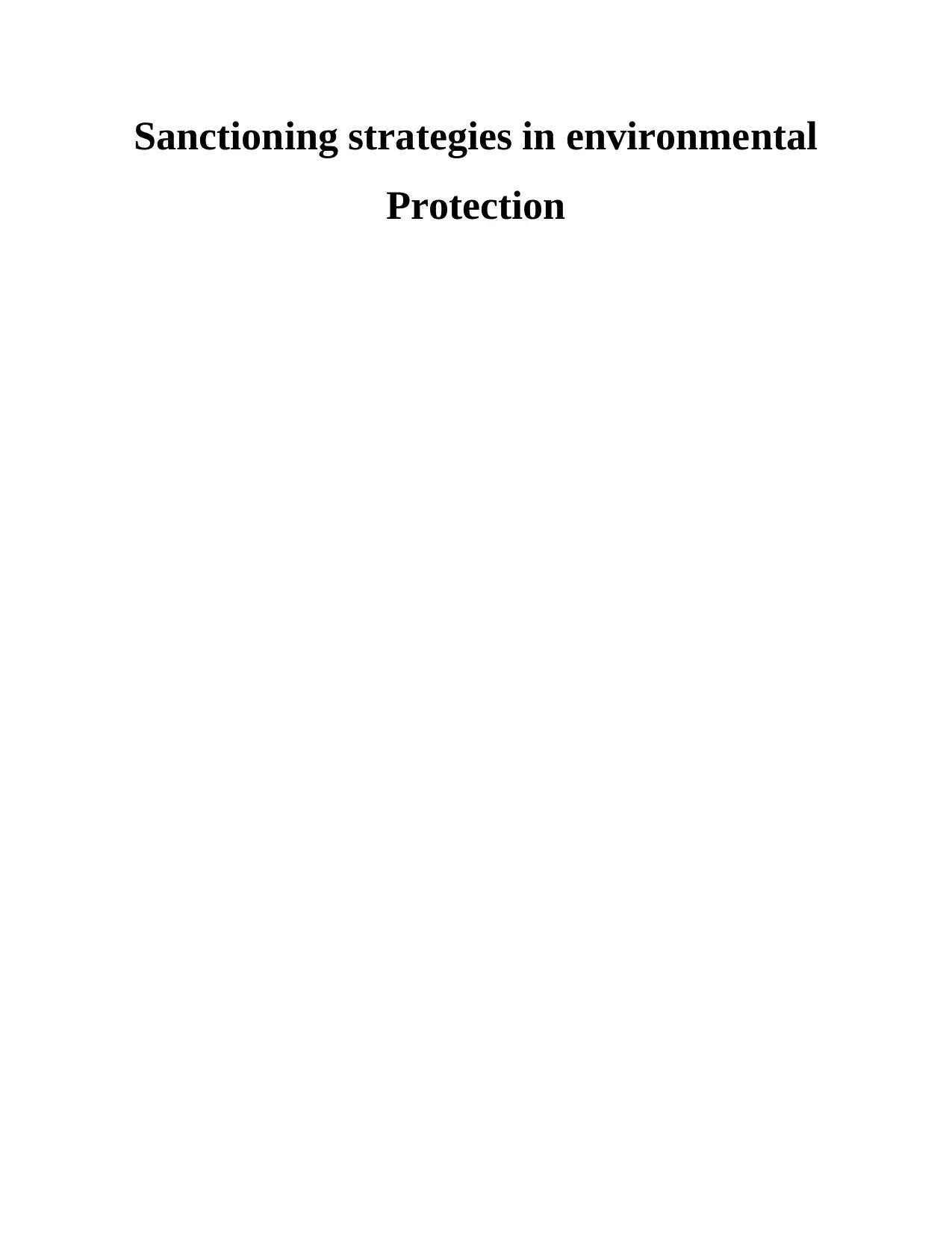
Sanctioning strategies in environmental
Protection
Protection
Paraphrase This Document
Need a fresh take? Get an instant paraphrase of this document with our AI Paraphraser
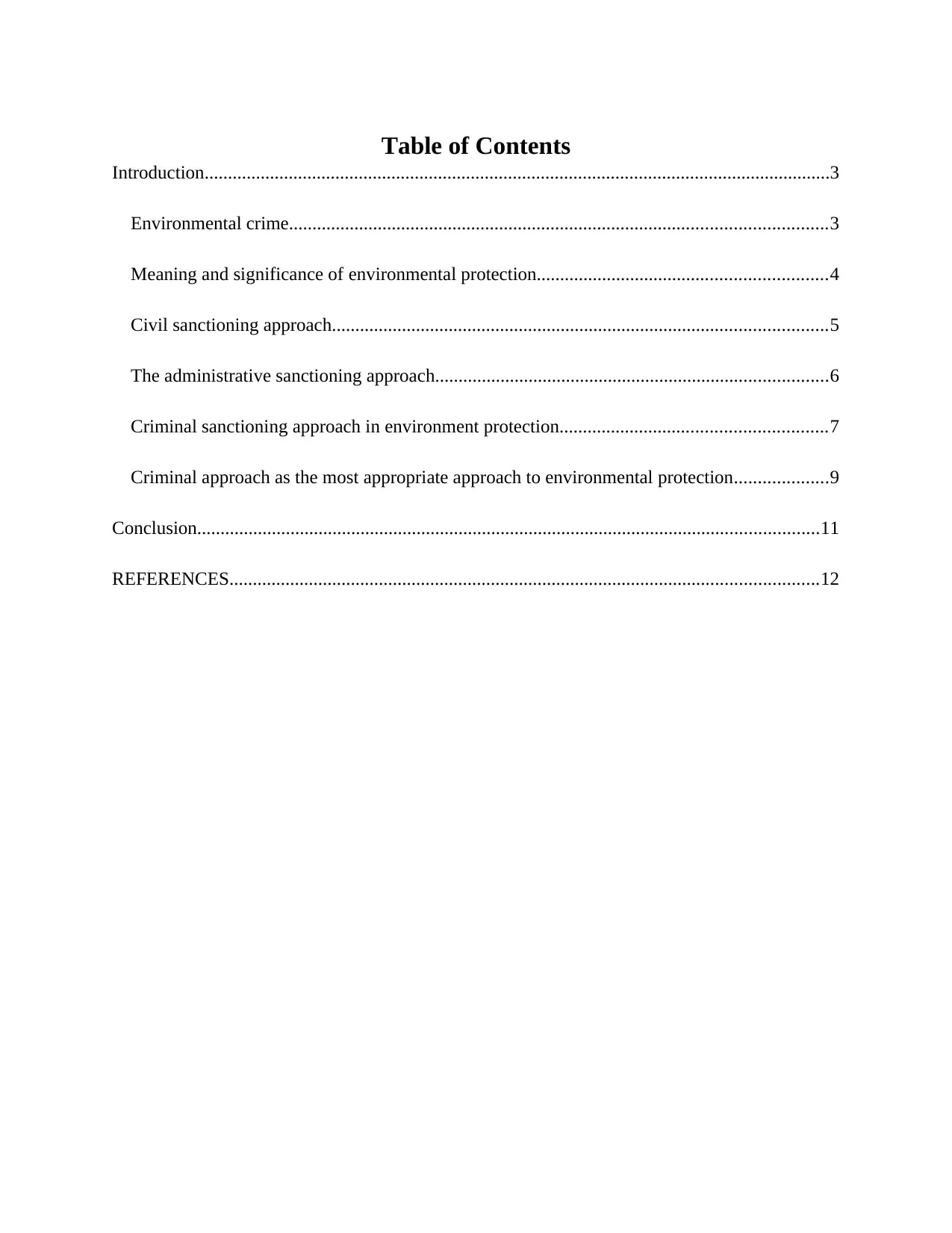
Table of Contents
Introduction......................................................................................................................................3
Environmental crime...................................................................................................................3
Meaning and significance of environmental protection..............................................................4
Civil sanctioning approach..........................................................................................................5
The administrative sanctioning approach....................................................................................6
Criminal sanctioning approach in environment protection.........................................................7
Criminal approach as the most appropriate approach to environmental protection....................9
Conclusion.....................................................................................................................................11
REFERENCES..............................................................................................................................12
Introduction......................................................................................................................................3
Environmental crime...................................................................................................................3
Meaning and significance of environmental protection..............................................................4
Civil sanctioning approach..........................................................................................................5
The administrative sanctioning approach....................................................................................6
Criminal sanctioning approach in environment protection.........................................................7
Criminal approach as the most appropriate approach to environmental protection....................9
Conclusion.....................................................................................................................................11
REFERENCES..............................................................................................................................12
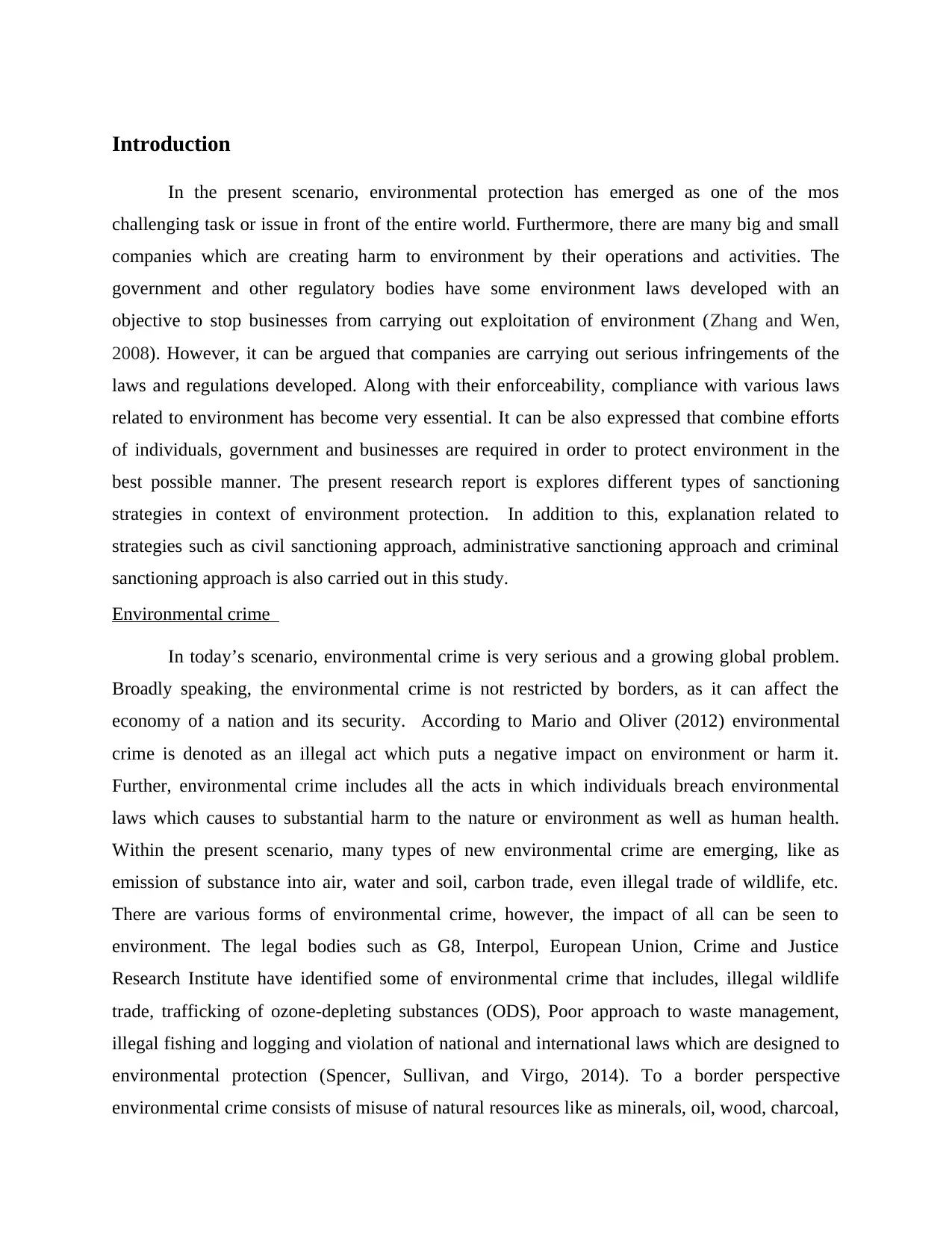
Introduction
In the present scenario, environmental protection has emerged as one of the mos
challenging task or issue in front of the entire world. Furthermore, there are many big and small
companies which are creating harm to environment by their operations and activities. The
government and other regulatory bodies have some environment laws developed with an
objective to stop businesses from carrying out exploitation of environment (Zhang and Wen,
2008). However, it can be argued that companies are carrying out serious infringements of the
laws and regulations developed. Along with their enforceability, compliance with various laws
related to environment has become very essential. It can be also expressed that combine efforts
of individuals, government and businesses are required in order to protect environment in the
best possible manner. The present research report is explores different types of sanctioning
strategies in context of environment protection. In addition to this, explanation related to
strategies such as civil sanctioning approach, administrative sanctioning approach and criminal
sanctioning approach is also carried out in this study.
Environmental crime
In today’s scenario, environmental crime is very serious and a growing global problem.
Broadly speaking, the environmental crime is not restricted by borders, as it can affect the
economy of a nation and its security. According to Mario and Oliver (2012) environmental
crime is denoted as an illegal act which puts a negative impact on environment or harm it.
Further, environmental crime includes all the acts in which individuals breach environmental
laws which causes to substantial harm to the nature or environment as well as human health.
Within the present scenario, many types of new environmental crime are emerging, like as
emission of substance into air, water and soil, carbon trade, even illegal trade of wildlife, etc.
There are various forms of environmental crime, however, the impact of all can be seen to
environment. The legal bodies such as G8, Interpol, European Union, Crime and Justice
Research Institute have identified some of environmental crime that includes, illegal wildlife
trade, trafficking of ozone-depleting substances (ODS), Poor approach to waste management,
illegal fishing and logging and violation of national and international laws which are designed to
environmental protection (Spencer, Sullivan, and Virgo, 2014). To a border perspective
environmental crime consists of misuse of natural resources like as minerals, oil, wood, charcoal,
In the present scenario, environmental protection has emerged as one of the mos
challenging task or issue in front of the entire world. Furthermore, there are many big and small
companies which are creating harm to environment by their operations and activities. The
government and other regulatory bodies have some environment laws developed with an
objective to stop businesses from carrying out exploitation of environment (Zhang and Wen,
2008). However, it can be argued that companies are carrying out serious infringements of the
laws and regulations developed. Along with their enforceability, compliance with various laws
related to environment has become very essential. It can be also expressed that combine efforts
of individuals, government and businesses are required in order to protect environment in the
best possible manner. The present research report is explores different types of sanctioning
strategies in context of environment protection. In addition to this, explanation related to
strategies such as civil sanctioning approach, administrative sanctioning approach and criminal
sanctioning approach is also carried out in this study.
Environmental crime
In today’s scenario, environmental crime is very serious and a growing global problem.
Broadly speaking, the environmental crime is not restricted by borders, as it can affect the
economy of a nation and its security. According to Mario and Oliver (2012) environmental
crime is denoted as an illegal act which puts a negative impact on environment or harm it.
Further, environmental crime includes all the acts in which individuals breach environmental
laws which causes to substantial harm to the nature or environment as well as human health.
Within the present scenario, many types of new environmental crime are emerging, like as
emission of substance into air, water and soil, carbon trade, even illegal trade of wildlife, etc.
There are various forms of environmental crime, however, the impact of all can be seen to
environment. The legal bodies such as G8, Interpol, European Union, Crime and Justice
Research Institute have identified some of environmental crime that includes, illegal wildlife
trade, trafficking of ozone-depleting substances (ODS), Poor approach to waste management,
illegal fishing and logging and violation of national and international laws which are designed to
environmental protection (Spencer, Sullivan, and Virgo, 2014). To a border perspective
environmental crime consists of misuse of natural resources like as minerals, oil, wood, charcoal,
⊘ This is a preview!⊘
Do you want full access?
Subscribe today to unlock all pages.

Trusted by 1+ million students worldwide
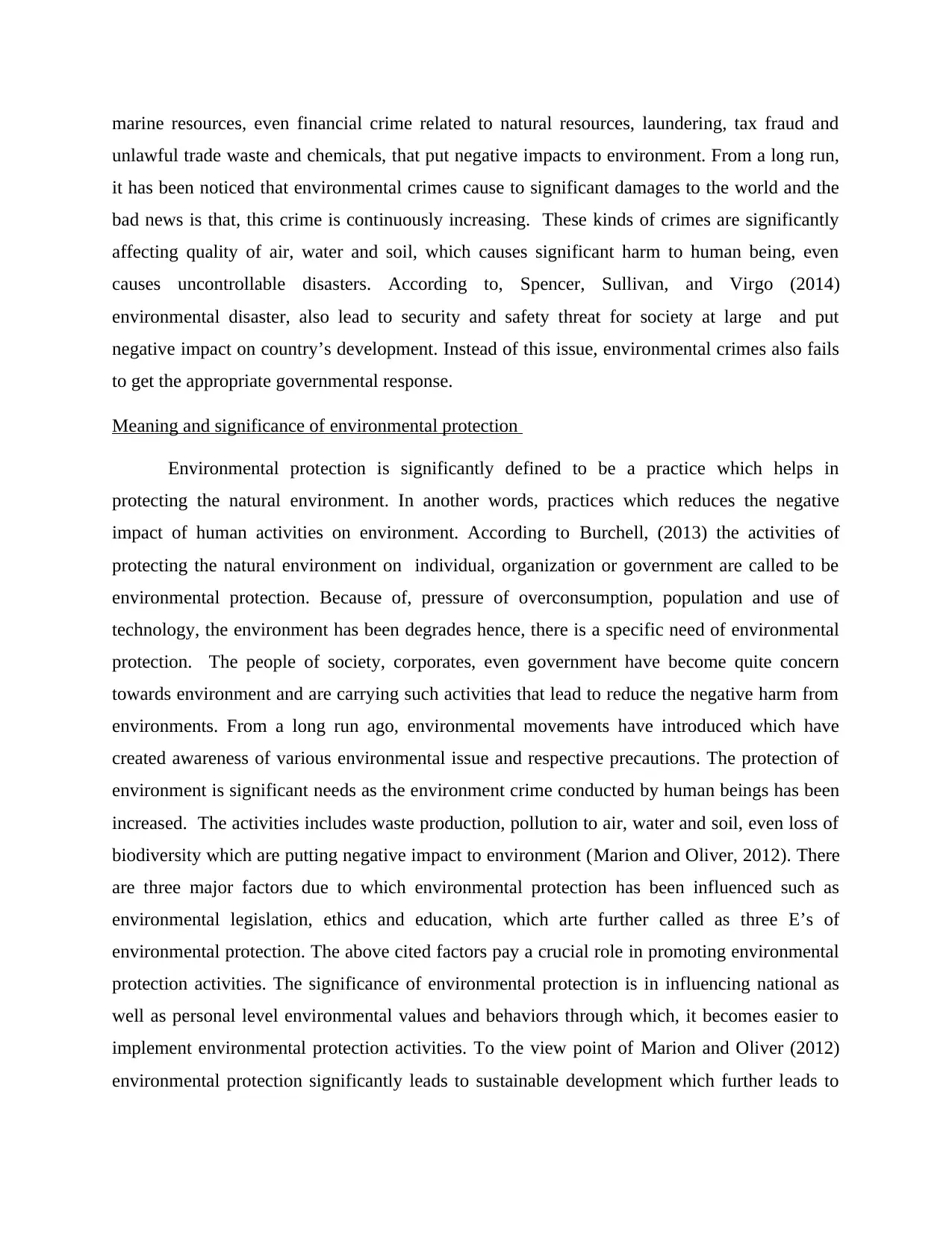
marine resources, even financial crime related to natural resources, laundering, tax fraud and
unlawful trade waste and chemicals, that put negative impacts to environment. From a long run,
it has been noticed that environmental crimes cause to significant damages to the world and the
bad news is that, this crime is continuously increasing. These kinds of crimes are significantly
affecting quality of air, water and soil, which causes significant harm to human being, even
causes uncontrollable disasters. According to, Spencer, Sullivan, and Virgo (2014)
environmental disaster, also lead to security and safety threat for society at large and put
negative impact on country’s development. Instead of this issue, environmental crimes also fails
to get the appropriate governmental response.
Meaning and significance of environmental protection
Environmental protection is significantly defined to be a practice which helps in
protecting the natural environment. In another words, practices which reduces the negative
impact of human activities on environment. According to Burchell, (2013) the activities of
protecting the natural environment on individual, organization or government are called to be
environmental protection. Because of, pressure of overconsumption, population and use of
technology, the environment has been degrades hence, there is a specific need of environmental
protection. The people of society, corporates, even government have become quite concern
towards environment and are carrying such activities that lead to reduce the negative harm from
environments. From a long run ago, environmental movements have introduced which have
created awareness of various environmental issue and respective precautions. The protection of
environment is significant needs as the environment crime conducted by human beings has been
increased. The activities includes waste production, pollution to air, water and soil, even loss of
biodiversity which are putting negative impact to environment (Marion and Oliver, 2012). There
are three major factors due to which environmental protection has been influenced such as
environmental legislation, ethics and education, which arte further called as three E’s of
environmental protection. The above cited factors pay a crucial role in promoting environmental
protection activities. The significance of environmental protection is in influencing national as
well as personal level environmental values and behaviors through which, it becomes easier to
implement environmental protection activities. To the view point of Marion and Oliver (2012)
environmental protection significantly leads to sustainable development which further leads to
unlawful trade waste and chemicals, that put negative impacts to environment. From a long run,
it has been noticed that environmental crimes cause to significant damages to the world and the
bad news is that, this crime is continuously increasing. These kinds of crimes are significantly
affecting quality of air, water and soil, which causes significant harm to human being, even
causes uncontrollable disasters. According to, Spencer, Sullivan, and Virgo (2014)
environmental disaster, also lead to security and safety threat for society at large and put
negative impact on country’s development. Instead of this issue, environmental crimes also fails
to get the appropriate governmental response.
Meaning and significance of environmental protection
Environmental protection is significantly defined to be a practice which helps in
protecting the natural environment. In another words, practices which reduces the negative
impact of human activities on environment. According to Burchell, (2013) the activities of
protecting the natural environment on individual, organization or government are called to be
environmental protection. Because of, pressure of overconsumption, population and use of
technology, the environment has been degrades hence, there is a specific need of environmental
protection. The people of society, corporates, even government have become quite concern
towards environment and are carrying such activities that lead to reduce the negative harm from
environments. From a long run ago, environmental movements have introduced which have
created awareness of various environmental issue and respective precautions. The protection of
environment is significant needs as the environment crime conducted by human beings has been
increased. The activities includes waste production, pollution to air, water and soil, even loss of
biodiversity which are putting negative impact to environment (Marion and Oliver, 2012). There
are three major factors due to which environmental protection has been influenced such as
environmental legislation, ethics and education, which arte further called as three E’s of
environmental protection. The above cited factors pay a crucial role in promoting environmental
protection activities. The significance of environmental protection is in influencing national as
well as personal level environmental values and behaviors through which, it becomes easier to
implement environmental protection activities. To the view point of Marion and Oliver (2012)
environmental protection significantly leads to sustainable development which further leads to
Paraphrase This Document
Need a fresh take? Get an instant paraphrase of this document with our AI Paraphraser
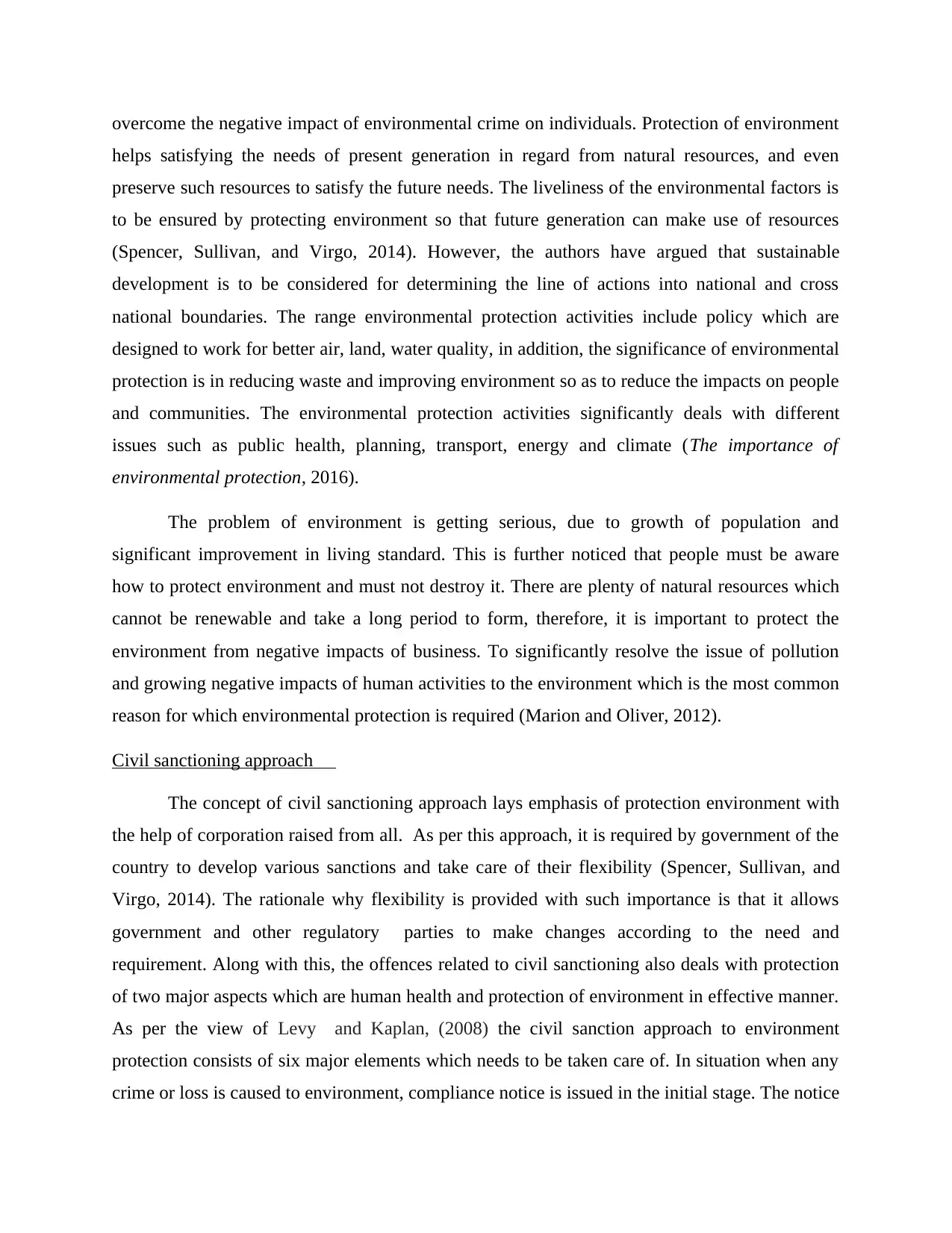
overcome the negative impact of environmental crime on individuals. Protection of environment
helps satisfying the needs of present generation in regard from natural resources, and even
preserve such resources to satisfy the future needs. The liveliness of the environmental factors is
to be ensured by protecting environment so that future generation can make use of resources
(Spencer, Sullivan, and Virgo, 2014). However, the authors have argued that sustainable
development is to be considered for determining the line of actions into national and cross
national boundaries. The range environmental protection activities include policy which are
designed to work for better air, land, water quality, in addition, the significance of environmental
protection is in reducing waste and improving environment so as to reduce the impacts on people
and communities. The environmental protection activities significantly deals with different
issues such as public health, planning, transport, energy and climate (The importance of
environmental protection, 2016).
The problem of environment is getting serious, due to growth of population and
significant improvement in living standard. This is further noticed that people must be aware
how to protect environment and must not destroy it. There are plenty of natural resources which
cannot be renewable and take a long period to form, therefore, it is important to protect the
environment from negative impacts of business. To significantly resolve the issue of pollution
and growing negative impacts of human activities to the environment which is the most common
reason for which environmental protection is required (Marion and Oliver, 2012).
Civil sanctioning approach
The concept of civil sanctioning approach lays emphasis of protection environment with
the help of corporation raised from all. As per this approach, it is required by government of the
country to develop various sanctions and take care of their flexibility (Spencer, Sullivan, and
Virgo, 2014). The rationale why flexibility is provided with such importance is that it allows
government and other regulatory parties to make changes according to the need and
requirement. Along with this, the offences related to civil sanctioning also deals with protection
of two major aspects which are human health and protection of environment in effective manner.
As per the view of Levy and Kaplan, (2008) the civil sanction approach to environment
protection consists of six major elements which needs to be taken care of. In situation when any
crime or loss is caused to environment, compliance notice is issued in the initial stage. The notice
helps satisfying the needs of present generation in regard from natural resources, and even
preserve such resources to satisfy the future needs. The liveliness of the environmental factors is
to be ensured by protecting environment so that future generation can make use of resources
(Spencer, Sullivan, and Virgo, 2014). However, the authors have argued that sustainable
development is to be considered for determining the line of actions into national and cross
national boundaries. The range environmental protection activities include policy which are
designed to work for better air, land, water quality, in addition, the significance of environmental
protection is in reducing waste and improving environment so as to reduce the impacts on people
and communities. The environmental protection activities significantly deals with different
issues such as public health, planning, transport, energy and climate (The importance of
environmental protection, 2016).
The problem of environment is getting serious, due to growth of population and
significant improvement in living standard. This is further noticed that people must be aware
how to protect environment and must not destroy it. There are plenty of natural resources which
cannot be renewable and take a long period to form, therefore, it is important to protect the
environment from negative impacts of business. To significantly resolve the issue of pollution
and growing negative impacts of human activities to the environment which is the most common
reason for which environmental protection is required (Marion and Oliver, 2012).
Civil sanctioning approach
The concept of civil sanctioning approach lays emphasis of protection environment with
the help of corporation raised from all. As per this approach, it is required by government of the
country to develop various sanctions and take care of their flexibility (Spencer, Sullivan, and
Virgo, 2014). The rationale why flexibility is provided with such importance is that it allows
government and other regulatory parties to make changes according to the need and
requirement. Along with this, the offences related to civil sanctioning also deals with protection
of two major aspects which are human health and protection of environment in effective manner.
As per the view of Levy and Kaplan, (2008) the civil sanction approach to environment
protection consists of six major elements which needs to be taken care of. In situation when any
crime or loss is caused to environment, compliance notice is issued in the initial stage. The notice
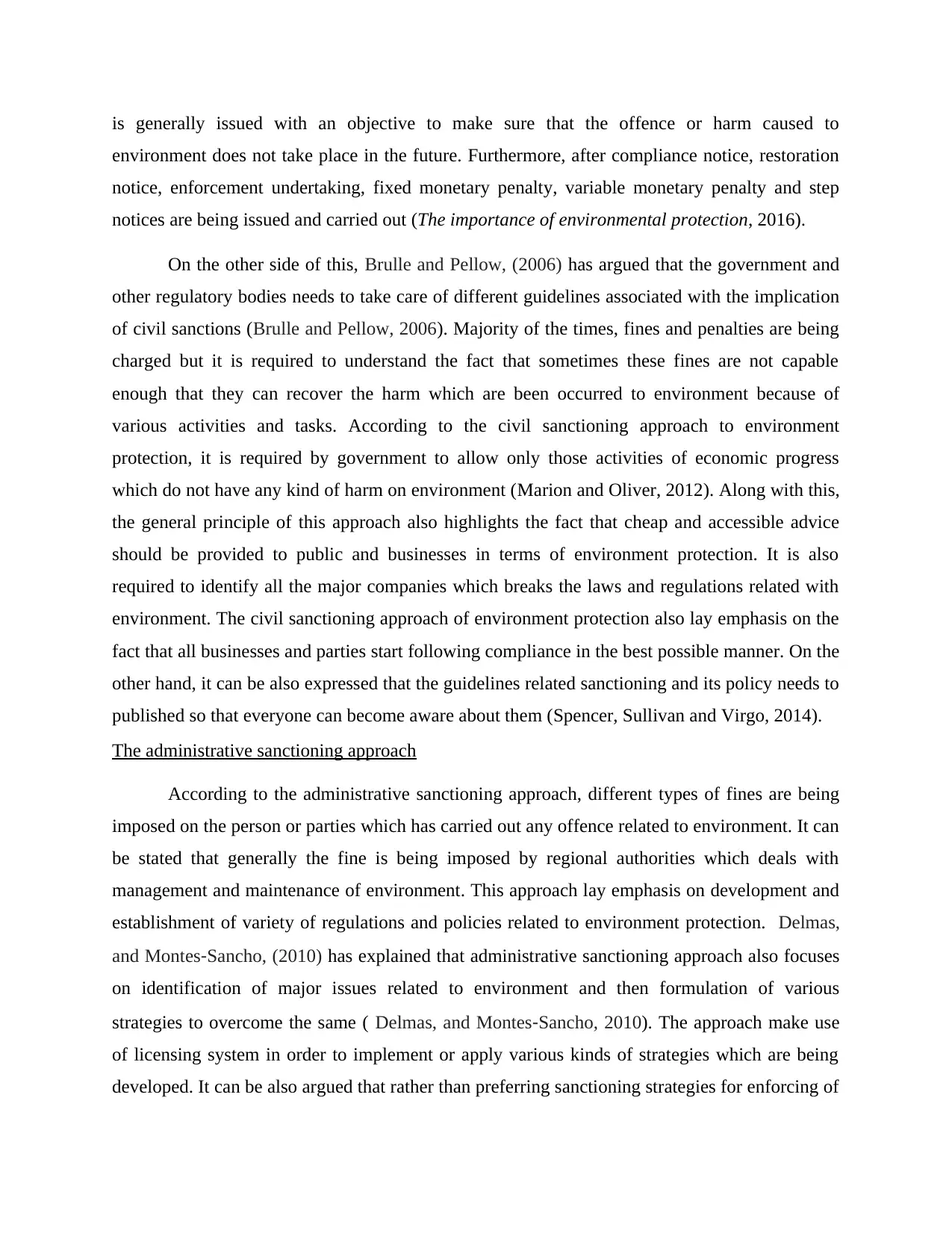
is generally issued with an objective to make sure that the offence or harm caused to
environment does not take place in the future. Furthermore, after compliance notice, restoration
notice, enforcement undertaking, fixed monetary penalty, variable monetary penalty and step
notices are being issued and carried out (The importance of environmental protection, 2016).
On the other side of this, Brulle and Pellow, (2006) has argued that the government and
other regulatory bodies needs to take care of different guidelines associated with the implication
of civil sanctions (Brulle and Pellow, 2006). Majority of the times, fines and penalties are being
charged but it is required to understand the fact that sometimes these fines are not capable
enough that they can recover the harm which are been occurred to environment because of
various activities and tasks. According to the civil sanctioning approach to environment
protection, it is required by government to allow only those activities of economic progress
which do not have any kind of harm on environment (Marion and Oliver, 2012). Along with this,
the general principle of this approach also highlights the fact that cheap and accessible advice
should be provided to public and businesses in terms of environment protection. It is also
required to identify all the major companies which breaks the laws and regulations related with
environment. The civil sanctioning approach of environment protection also lay emphasis on the
fact that all businesses and parties start following compliance in the best possible manner. On the
other hand, it can be also expressed that the guidelines related sanctioning and its policy needs to
published so that everyone can become aware about them (Spencer, Sullivan and Virgo, 2014).
The administrative sanctioning approach
According to the administrative sanctioning approach, different types of fines are being
imposed on the person or parties which has carried out any offence related to environment. It can
be stated that generally the fine is being imposed by regional authorities which deals with
management and maintenance of environment. This approach lay emphasis on development and
establishment of variety of regulations and policies related to environment protection. Delmas,
and Montes‐Sancho, (2010) has explained that administrative sanctioning approach also focuses
on identification of major issues related to environment and then formulation of various
strategies to overcome the same ( Delmas, and Montes‐Sancho, 2010). The approach make use
of licensing system in order to implement or apply various kinds of strategies which are being
developed. It can be also argued that rather than preferring sanctioning strategies for enforcing of
environment does not take place in the future. Furthermore, after compliance notice, restoration
notice, enforcement undertaking, fixed monetary penalty, variable monetary penalty and step
notices are being issued and carried out (The importance of environmental protection, 2016).
On the other side of this, Brulle and Pellow, (2006) has argued that the government and
other regulatory bodies needs to take care of different guidelines associated with the implication
of civil sanctions (Brulle and Pellow, 2006). Majority of the times, fines and penalties are being
charged but it is required to understand the fact that sometimes these fines are not capable
enough that they can recover the harm which are been occurred to environment because of
various activities and tasks. According to the civil sanctioning approach to environment
protection, it is required by government to allow only those activities of economic progress
which do not have any kind of harm on environment (Marion and Oliver, 2012). Along with this,
the general principle of this approach also highlights the fact that cheap and accessible advice
should be provided to public and businesses in terms of environment protection. It is also
required to identify all the major companies which breaks the laws and regulations related with
environment. The civil sanctioning approach of environment protection also lay emphasis on the
fact that all businesses and parties start following compliance in the best possible manner. On the
other hand, it can be also expressed that the guidelines related sanctioning and its policy needs to
published so that everyone can become aware about them (Spencer, Sullivan and Virgo, 2014).
The administrative sanctioning approach
According to the administrative sanctioning approach, different types of fines are being
imposed on the person or parties which has carried out any offence related to environment. It can
be stated that generally the fine is being imposed by regional authorities which deals with
management and maintenance of environment. This approach lay emphasis on development and
establishment of variety of regulations and policies related to environment protection. Delmas,
and Montes‐Sancho, (2010) has explained that administrative sanctioning approach also focuses
on identification of major issues related to environment and then formulation of various
strategies to overcome the same ( Delmas, and Montes‐Sancho, 2010). The approach make use
of licensing system in order to implement or apply various kinds of strategies which are being
developed. It can be also argued that rather than preferring sanctioning strategies for enforcing of
⊘ This is a preview!⊘
Do you want full access?
Subscribe today to unlock all pages.

Trusted by 1+ million students worldwide
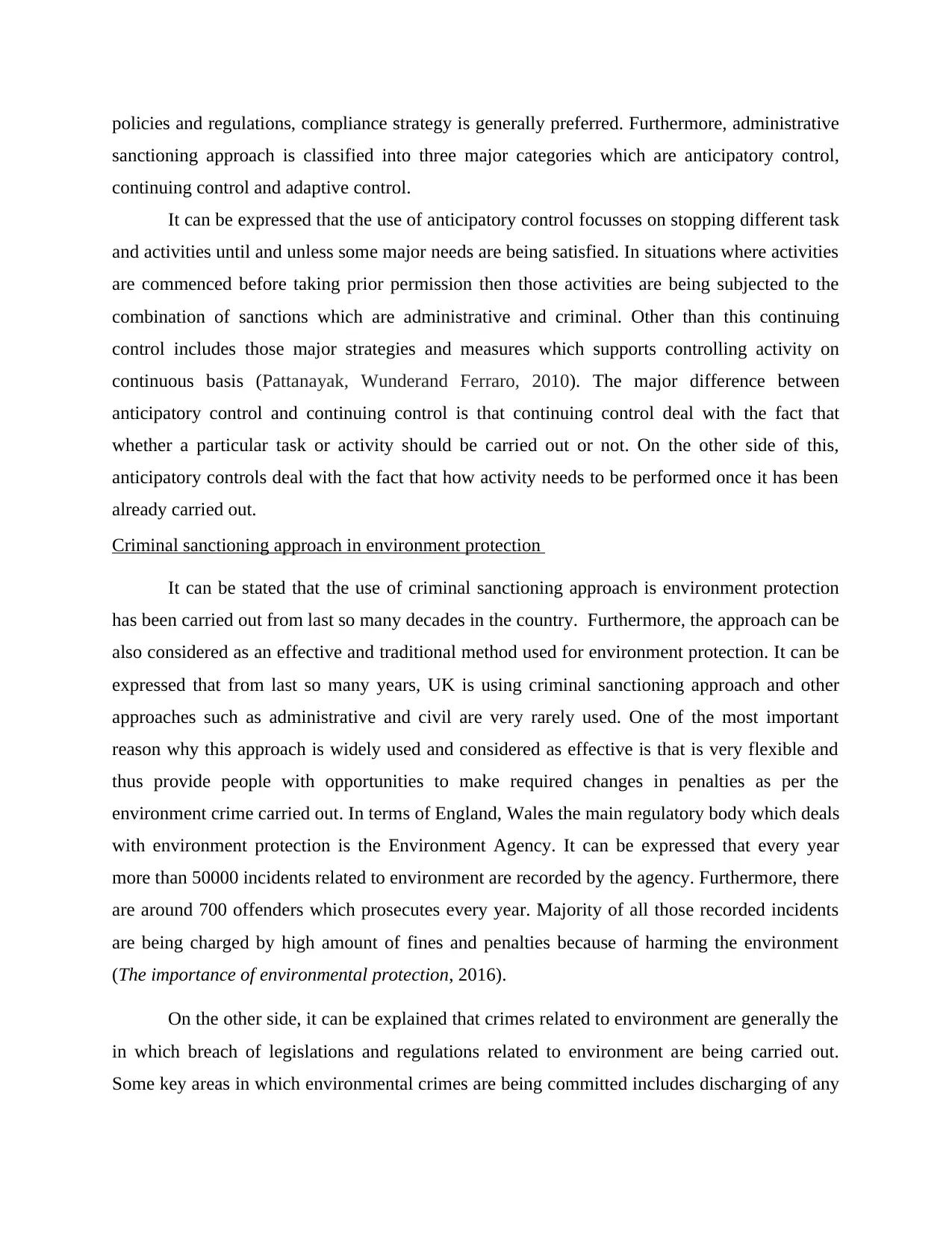
policies and regulations, compliance strategy is generally preferred. Furthermore, administrative
sanctioning approach is classified into three major categories which are anticipatory control,
continuing control and adaptive control.
It can be expressed that the use of anticipatory control focusses on stopping different task
and activities until and unless some major needs are being satisfied. In situations where activities
are commenced before taking prior permission then those activities are being subjected to the
combination of sanctions which are administrative and criminal. Other than this continuing
control includes those major strategies and measures which supports controlling activity on
continuous basis (Pattanayak, Wunderand Ferraro, 2010). The major difference between
anticipatory control and continuing control is that continuing control deal with the fact that
whether a particular task or activity should be carried out or not. On the other side of this,
anticipatory controls deal with the fact that how activity needs to be performed once it has been
already carried out.
Criminal sanctioning approach in environment protection
It can be stated that the use of criminal sanctioning approach is environment protection
has been carried out from last so many decades in the country. Furthermore, the approach can be
also considered as an effective and traditional method used for environment protection. It can be
expressed that from last so many years, UK is using criminal sanctioning approach and other
approaches such as administrative and civil are very rarely used. One of the most important
reason why this approach is widely used and considered as effective is that is very flexible and
thus provide people with opportunities to make required changes in penalties as per the
environment crime carried out. In terms of England, Wales the main regulatory body which deals
with environment protection is the Environment Agency. It can be expressed that every year
more than 50000 incidents related to environment are recorded by the agency. Furthermore, there
are around 700 offenders which prosecutes every year. Majority of all those recorded incidents
are being charged by high amount of fines and penalties because of harming the environment
(The importance of environmental protection, 2016).
On the other side, it can be explained that crimes related to environment are generally the
in which breach of legislations and regulations related to environment are being carried out.
Some key areas in which environmental crimes are being committed includes discharging of any
sanctioning approach is classified into three major categories which are anticipatory control,
continuing control and adaptive control.
It can be expressed that the use of anticipatory control focusses on stopping different task
and activities until and unless some major needs are being satisfied. In situations where activities
are commenced before taking prior permission then those activities are being subjected to the
combination of sanctions which are administrative and criminal. Other than this continuing
control includes those major strategies and measures which supports controlling activity on
continuous basis (Pattanayak, Wunderand Ferraro, 2010). The major difference between
anticipatory control and continuing control is that continuing control deal with the fact that
whether a particular task or activity should be carried out or not. On the other side of this,
anticipatory controls deal with the fact that how activity needs to be performed once it has been
already carried out.
Criminal sanctioning approach in environment protection
It can be stated that the use of criminal sanctioning approach is environment protection
has been carried out from last so many decades in the country. Furthermore, the approach can be
also considered as an effective and traditional method used for environment protection. It can be
expressed that from last so many years, UK is using criminal sanctioning approach and other
approaches such as administrative and civil are very rarely used. One of the most important
reason why this approach is widely used and considered as effective is that is very flexible and
thus provide people with opportunities to make required changes in penalties as per the
environment crime carried out. In terms of England, Wales the main regulatory body which deals
with environment protection is the Environment Agency. It can be expressed that every year
more than 50000 incidents related to environment are recorded by the agency. Furthermore, there
are around 700 offenders which prosecutes every year. Majority of all those recorded incidents
are being charged by high amount of fines and penalties because of harming the environment
(The importance of environmental protection, 2016).
On the other side, it can be explained that crimes related to environment are generally the
in which breach of legislations and regulations related to environment are being carried out.
Some key areas in which environmental crimes are being committed includes discharging of any
Paraphrase This Document
Need a fresh take? Get an instant paraphrase of this document with our AI Paraphraser
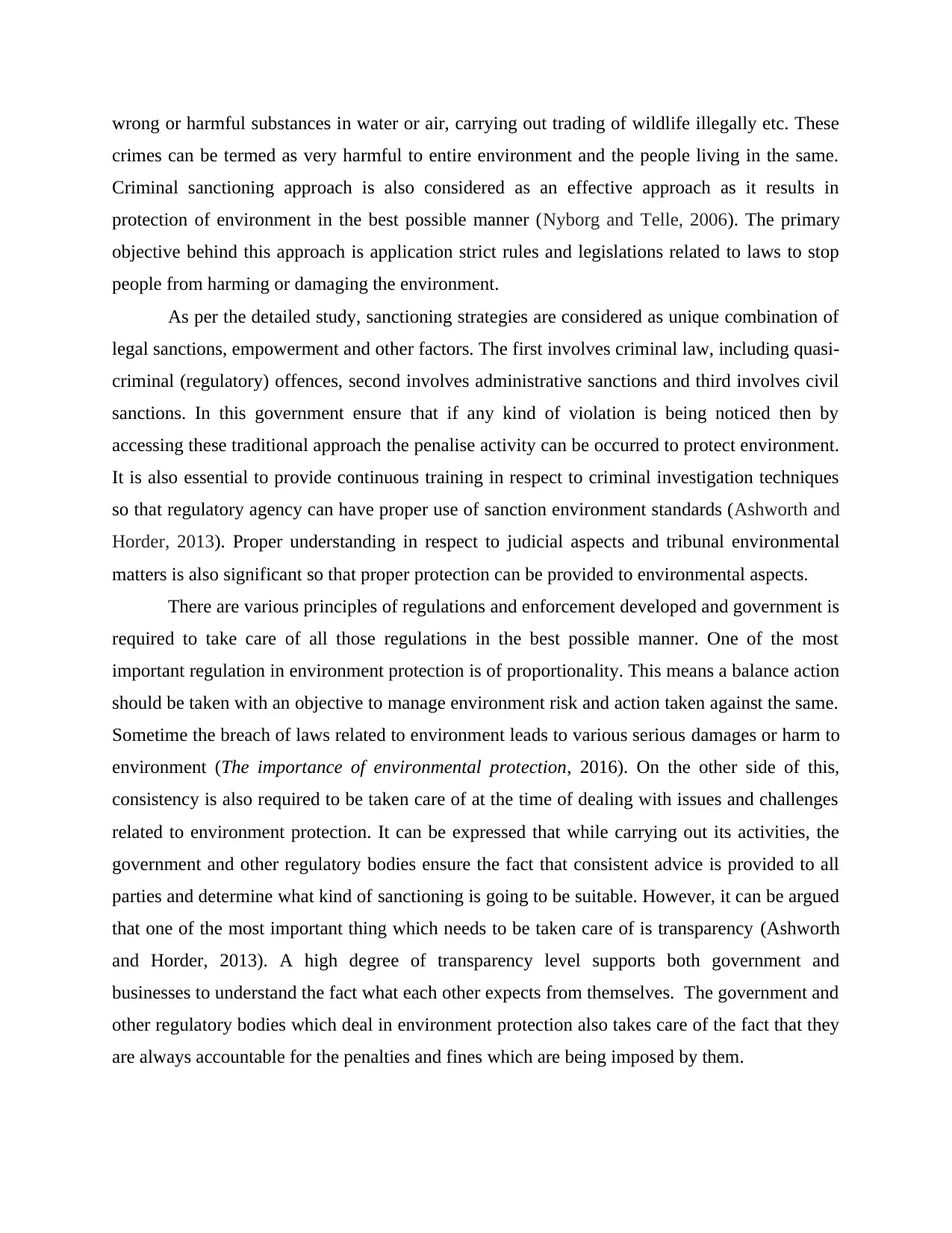
wrong or harmful substances in water or air, carrying out trading of wildlife illegally etc. These
crimes can be termed as very harmful to entire environment and the people living in the same.
Criminal sanctioning approach is also considered as an effective approach as it results in
protection of environment in the best possible manner (Nyborg and Telle, 2006). The primary
objective behind this approach is application strict rules and legislations related to laws to stop
people from harming or damaging the environment.
As per the detailed study, sanctioning strategies are considered as unique combination of
legal sanctions, empowerment and other factors. The first involves criminal law, including quasi-
criminal (regulatory) offences, second involves administrative sanctions and third involves civil
sanctions. In this government ensure that if any kind of violation is being noticed then by
accessing these traditional approach the penalise activity can be occurred to protect environment.
It is also essential to provide continuous training in respect to criminal investigation techniques
so that regulatory agency can have proper use of sanction environment standards (Ashworth and
Horder, 2013). Proper understanding in respect to judicial aspects and tribunal environmental
matters is also significant so that proper protection can be provided to environmental aspects.
There are various principles of regulations and enforcement developed and government is
required to take care of all those regulations in the best possible manner. One of the most
important regulation in environment protection is of proportionality. This means a balance action
should be taken with an objective to manage environment risk and action taken against the same.
Sometime the breach of laws related to environment leads to various serious damages or harm to
environment (The importance of environmental protection, 2016). On the other side of this,
consistency is also required to be taken care of at the time of dealing with issues and challenges
related to environment protection. It can be expressed that while carrying out its activities, the
government and other regulatory bodies ensure the fact that consistent advice is provided to all
parties and determine what kind of sanctioning is going to be suitable. However, it can be argued
that one of the most important thing which needs to be taken care of is transparency (Ashworth
and Horder, 2013). A high degree of transparency level supports both government and
businesses to understand the fact what each other expects from themselves. The government and
other regulatory bodies which deal in environment protection also takes care of the fact that they
are always accountable for the penalties and fines which are being imposed by them.
crimes can be termed as very harmful to entire environment and the people living in the same.
Criminal sanctioning approach is also considered as an effective approach as it results in
protection of environment in the best possible manner (Nyborg and Telle, 2006). The primary
objective behind this approach is application strict rules and legislations related to laws to stop
people from harming or damaging the environment.
As per the detailed study, sanctioning strategies are considered as unique combination of
legal sanctions, empowerment and other factors. The first involves criminal law, including quasi-
criminal (regulatory) offences, second involves administrative sanctions and third involves civil
sanctions. In this government ensure that if any kind of violation is being noticed then by
accessing these traditional approach the penalise activity can be occurred to protect environment.
It is also essential to provide continuous training in respect to criminal investigation techniques
so that regulatory agency can have proper use of sanction environment standards (Ashworth and
Horder, 2013). Proper understanding in respect to judicial aspects and tribunal environmental
matters is also significant so that proper protection can be provided to environmental aspects.
There are various principles of regulations and enforcement developed and government is
required to take care of all those regulations in the best possible manner. One of the most
important regulation in environment protection is of proportionality. This means a balance action
should be taken with an objective to manage environment risk and action taken against the same.
Sometime the breach of laws related to environment leads to various serious damages or harm to
environment (The importance of environmental protection, 2016). On the other side of this,
consistency is also required to be taken care of at the time of dealing with issues and challenges
related to environment protection. It can be expressed that while carrying out its activities, the
government and other regulatory bodies ensure the fact that consistent advice is provided to all
parties and determine what kind of sanctioning is going to be suitable. However, it can be argued
that one of the most important thing which needs to be taken care of is transparency (Ashworth
and Horder, 2013). A high degree of transparency level supports both government and
businesses to understand the fact what each other expects from themselves. The government and
other regulatory bodies which deal in environment protection also takes care of the fact that they
are always accountable for the penalties and fines which are being imposed by them.
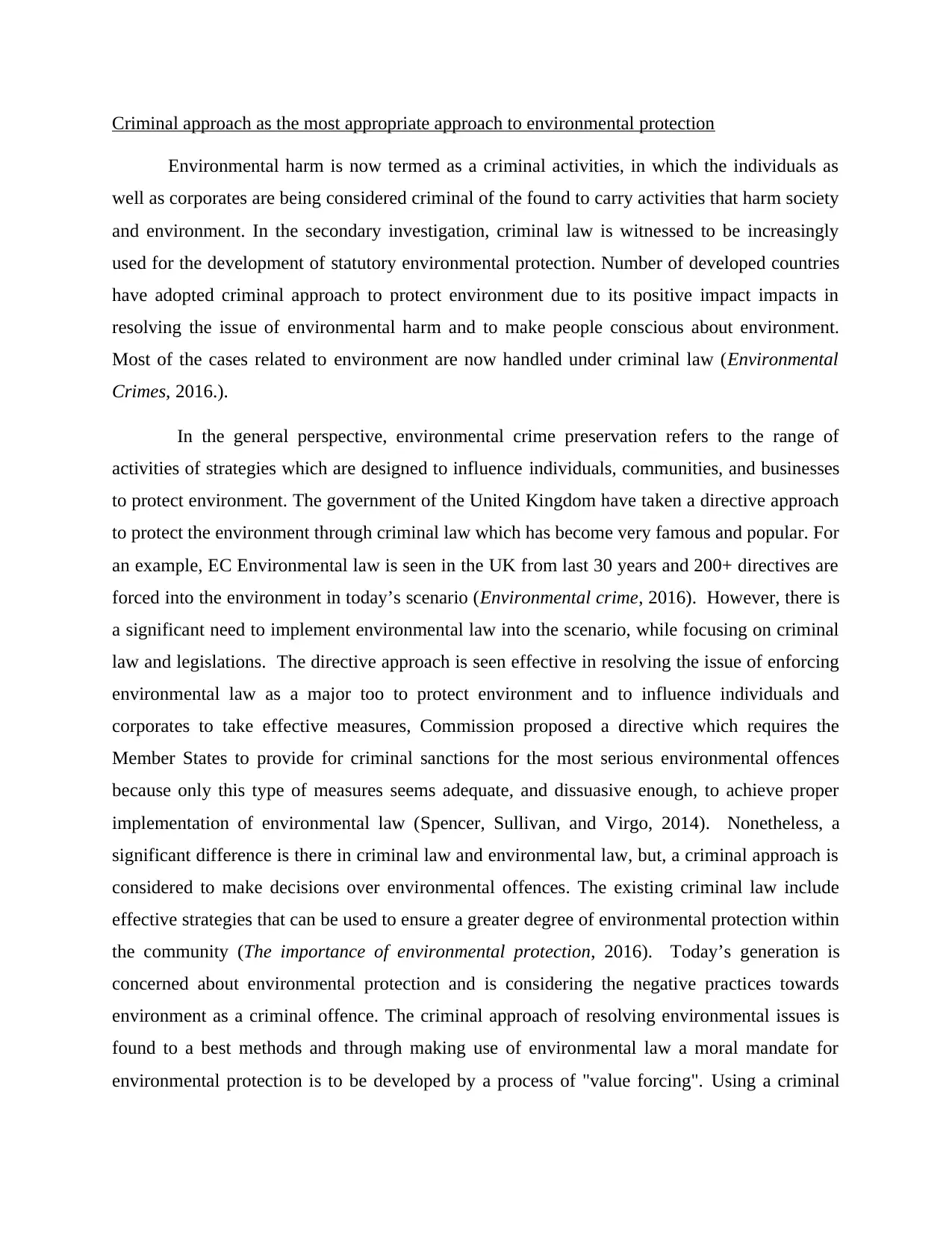
Criminal approach as the most appropriate approach to environmental protection
Environmental harm is now termed as a criminal activities, in which the individuals as
well as corporates are being considered criminal of the found to carry activities that harm society
and environment. In the secondary investigation, criminal law is witnessed to be increasingly
used for the development of statutory environmental protection. Number of developed countries
have adopted criminal approach to protect environment due to its positive impact impacts in
resolving the issue of environmental harm and to make people conscious about environment.
Most of the cases related to environment are now handled under criminal law (Environmental
Crimes, 2016.).
In the general perspective, environmental crime preservation refers to the range of
activities of strategies which are designed to influence individuals, communities, and businesses
to protect environment. The government of the United Kingdom have taken a directive approach
to protect the environment through criminal law which has become very famous and popular. For
an example, EC Environmental law is seen in the UK from last 30 years and 200+ directives are
forced into the environment in today’s scenario (Environmental crime, 2016). However, there is
a significant need to implement environmental law into the scenario, while focusing on criminal
law and legislations. The directive approach is seen effective in resolving the issue of enforcing
environmental law as a major too to protect environment and to influence individuals and
corporates to take effective measures, Commission proposed a directive which requires the
Member States to provide for criminal sanctions for the most serious environmental offences
because only this type of measures seems adequate, and dissuasive enough, to achieve proper
implementation of environmental law (Spencer, Sullivan, and Virgo, 2014). Nonetheless, a
significant difference is there in criminal law and environmental law, but, a criminal approach is
considered to make decisions over environmental offences. The existing criminal law include
effective strategies that can be used to ensure a greater degree of environmental protection within
the community (The importance of environmental protection, 2016). Today’s generation is
concerned about environmental protection and is considering the negative practices towards
environment as a criminal offence. The criminal approach of resolving environmental issues is
found to a best methods and through making use of environmental law a moral mandate for
environmental protection is to be developed by a process of "value forcing". Using a criminal
Environmental harm is now termed as a criminal activities, in which the individuals as
well as corporates are being considered criminal of the found to carry activities that harm society
and environment. In the secondary investigation, criminal law is witnessed to be increasingly
used for the development of statutory environmental protection. Number of developed countries
have adopted criminal approach to protect environment due to its positive impact impacts in
resolving the issue of environmental harm and to make people conscious about environment.
Most of the cases related to environment are now handled under criminal law (Environmental
Crimes, 2016.).
In the general perspective, environmental crime preservation refers to the range of
activities of strategies which are designed to influence individuals, communities, and businesses
to protect environment. The government of the United Kingdom have taken a directive approach
to protect the environment through criminal law which has become very famous and popular. For
an example, EC Environmental law is seen in the UK from last 30 years and 200+ directives are
forced into the environment in today’s scenario (Environmental crime, 2016). However, there is
a significant need to implement environmental law into the scenario, while focusing on criminal
law and legislations. The directive approach is seen effective in resolving the issue of enforcing
environmental law as a major too to protect environment and to influence individuals and
corporates to take effective measures, Commission proposed a directive which requires the
Member States to provide for criminal sanctions for the most serious environmental offences
because only this type of measures seems adequate, and dissuasive enough, to achieve proper
implementation of environmental law (Spencer, Sullivan, and Virgo, 2014). Nonetheless, a
significant difference is there in criminal law and environmental law, but, a criminal approach is
considered to make decisions over environmental offences. The existing criminal law include
effective strategies that can be used to ensure a greater degree of environmental protection within
the community (The importance of environmental protection, 2016). Today’s generation is
concerned about environmental protection and is considering the negative practices towards
environment as a criminal offence. The criminal approach of resolving environmental issues is
found to a best methods and through making use of environmental law a moral mandate for
environmental protection is to be developed by a process of "value forcing". Using a criminal
⊘ This is a preview!⊘
Do you want full access?
Subscribe today to unlock all pages.

Trusted by 1+ million students worldwide
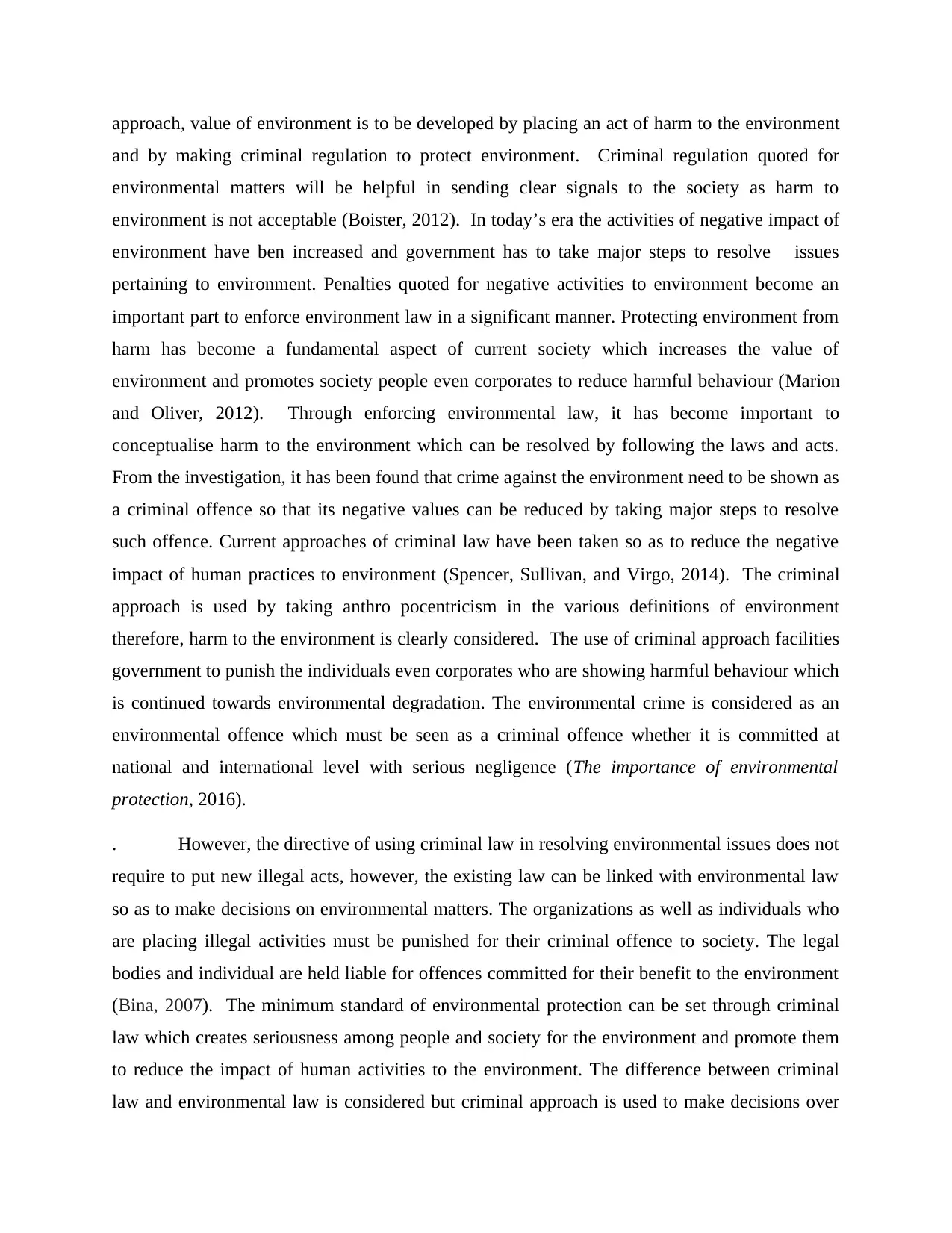
approach, value of environment is to be developed by placing an act of harm to the environment
and by making criminal regulation to protect environment. Criminal regulation quoted for
environmental matters will be helpful in sending clear signals to the society as harm to
environment is not acceptable (Boister, 2012). In today’s era the activities of negative impact of
environment have ben increased and government has to take major steps to resolve issues
pertaining to environment. Penalties quoted for negative activities to environment become an
important part to enforce environment law in a significant manner. Protecting environment from
harm has become a fundamental aspect of current society which increases the value of
environment and promotes society people even corporates to reduce harmful behaviour (Marion
and Oliver, 2012). Through enforcing environmental law, it has become important to
conceptualise harm to the environment which can be resolved by following the laws and acts.
From the investigation, it has been found that crime against the environment need to be shown as
a criminal offence so that its negative values can be reduced by taking major steps to resolve
such offence. Current approaches of criminal law have been taken so as to reduce the negative
impact of human practices to environment (Spencer, Sullivan, and Virgo, 2014). The criminal
approach is used by taking anthro pocentricism in the various definitions of environment
therefore, harm to the environment is clearly considered. The use of criminal approach facilities
government to punish the individuals even corporates who are showing harmful behaviour which
is continued towards environmental degradation. The environmental crime is considered as an
environmental offence which must be seen as a criminal offence whether it is committed at
national and international level with serious negligence (The importance of environmental
protection, 2016).
. However, the directive of using criminal law in resolving environmental issues does not
require to put new illegal acts, however, the existing law can be linked with environmental law
so as to make decisions on environmental matters. The organizations as well as individuals who
are placing illegal activities must be punished for their criminal offence to society. The legal
bodies and individual are held liable for offences committed for their benefit to the environment
(Bina, 2007). The minimum standard of environmental protection can be set through criminal
law which creates seriousness among people and society for the environment and promote them
to reduce the impact of human activities to the environment. The difference between criminal
law and environmental law is considered but criminal approach is used to make decisions over
and by making criminal regulation to protect environment. Criminal regulation quoted for
environmental matters will be helpful in sending clear signals to the society as harm to
environment is not acceptable (Boister, 2012). In today’s era the activities of negative impact of
environment have ben increased and government has to take major steps to resolve issues
pertaining to environment. Penalties quoted for negative activities to environment become an
important part to enforce environment law in a significant manner. Protecting environment from
harm has become a fundamental aspect of current society which increases the value of
environment and promotes society people even corporates to reduce harmful behaviour (Marion
and Oliver, 2012). Through enforcing environmental law, it has become important to
conceptualise harm to the environment which can be resolved by following the laws and acts.
From the investigation, it has been found that crime against the environment need to be shown as
a criminal offence so that its negative values can be reduced by taking major steps to resolve
such offence. Current approaches of criminal law have been taken so as to reduce the negative
impact of human practices to environment (Spencer, Sullivan, and Virgo, 2014). The criminal
approach is used by taking anthro pocentricism in the various definitions of environment
therefore, harm to the environment is clearly considered. The use of criminal approach facilities
government to punish the individuals even corporates who are showing harmful behaviour which
is continued towards environmental degradation. The environmental crime is considered as an
environmental offence which must be seen as a criminal offence whether it is committed at
national and international level with serious negligence (The importance of environmental
protection, 2016).
. However, the directive of using criminal law in resolving environmental issues does not
require to put new illegal acts, however, the existing law can be linked with environmental law
so as to make decisions on environmental matters. The organizations as well as individuals who
are placing illegal activities must be punished for their criminal offence to society. The legal
bodies and individual are held liable for offences committed for their benefit to the environment
(Bina, 2007). The minimum standard of environmental protection can be set through criminal
law which creates seriousness among people and society for the environment and promote them
to reduce the impact of human activities to the environment. The difference between criminal
law and environmental law is considered but criminal approach is used to make decisions over
Paraphrase This Document
Need a fresh take? Get an instant paraphrase of this document with our AI Paraphraser
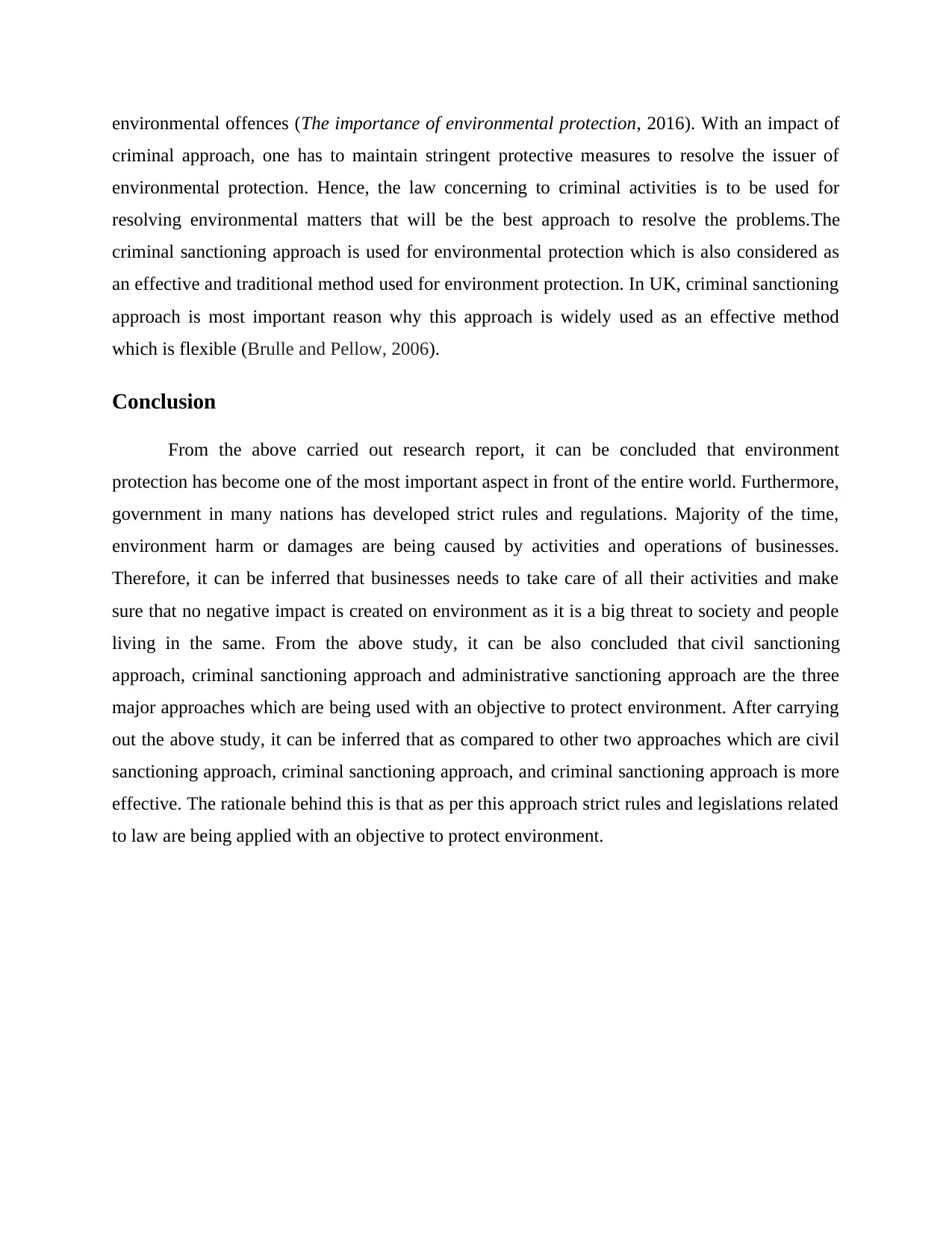
environmental offences (The importance of environmental protection, 2016). With an impact of
criminal approach, one has to maintain stringent protective measures to resolve the issuer of
environmental protection. Hence, the law concerning to criminal activities is to be used for
resolving environmental matters that will be the best approach to resolve the problems.The
criminal sanctioning approach is used for environmental protection which is also considered as
an effective and traditional method used for environment protection. In UK, criminal sanctioning
approach is most important reason why this approach is widely used as an effective method
which is flexible (Brulle and Pellow, 2006).
Conclusion
From the above carried out research report, it can be concluded that environment
protection has become one of the most important aspect in front of the entire world. Furthermore,
government in many nations has developed strict rules and regulations. Majority of the time,
environment harm or damages are being caused by activities and operations of businesses.
Therefore, it can be inferred that businesses needs to take care of all their activities and make
sure that no negative impact is created on environment as it is a big threat to society and people
living in the same. From the above study, it can be also concluded that civil sanctioning
approach, criminal sanctioning approach and administrative sanctioning approach are the three
major approaches which are being used with an objective to protect environment. After carrying
out the above study, it can be inferred that as compared to other two approaches which are civil
sanctioning approach, criminal sanctioning approach, and criminal sanctioning approach is more
effective. The rationale behind this is that as per this approach strict rules and legislations related
to law are being applied with an objective to protect environment.
criminal approach, one has to maintain stringent protective measures to resolve the issuer of
environmental protection. Hence, the law concerning to criminal activities is to be used for
resolving environmental matters that will be the best approach to resolve the problems.The
criminal sanctioning approach is used for environmental protection which is also considered as
an effective and traditional method used for environment protection. In UK, criminal sanctioning
approach is most important reason why this approach is widely used as an effective method
which is flexible (Brulle and Pellow, 2006).
Conclusion
From the above carried out research report, it can be concluded that environment
protection has become one of the most important aspect in front of the entire world. Furthermore,
government in many nations has developed strict rules and regulations. Majority of the time,
environment harm or damages are being caused by activities and operations of businesses.
Therefore, it can be inferred that businesses needs to take care of all their activities and make
sure that no negative impact is created on environment as it is a big threat to society and people
living in the same. From the above study, it can be also concluded that civil sanctioning
approach, criminal sanctioning approach and administrative sanctioning approach are the three
major approaches which are being used with an objective to protect environment. After carrying
out the above study, it can be inferred that as compared to other two approaches which are civil
sanctioning approach, criminal sanctioning approach, and criminal sanctioning approach is more
effective. The rationale behind this is that as per this approach strict rules and legislations related
to law are being applied with an objective to protect environment.
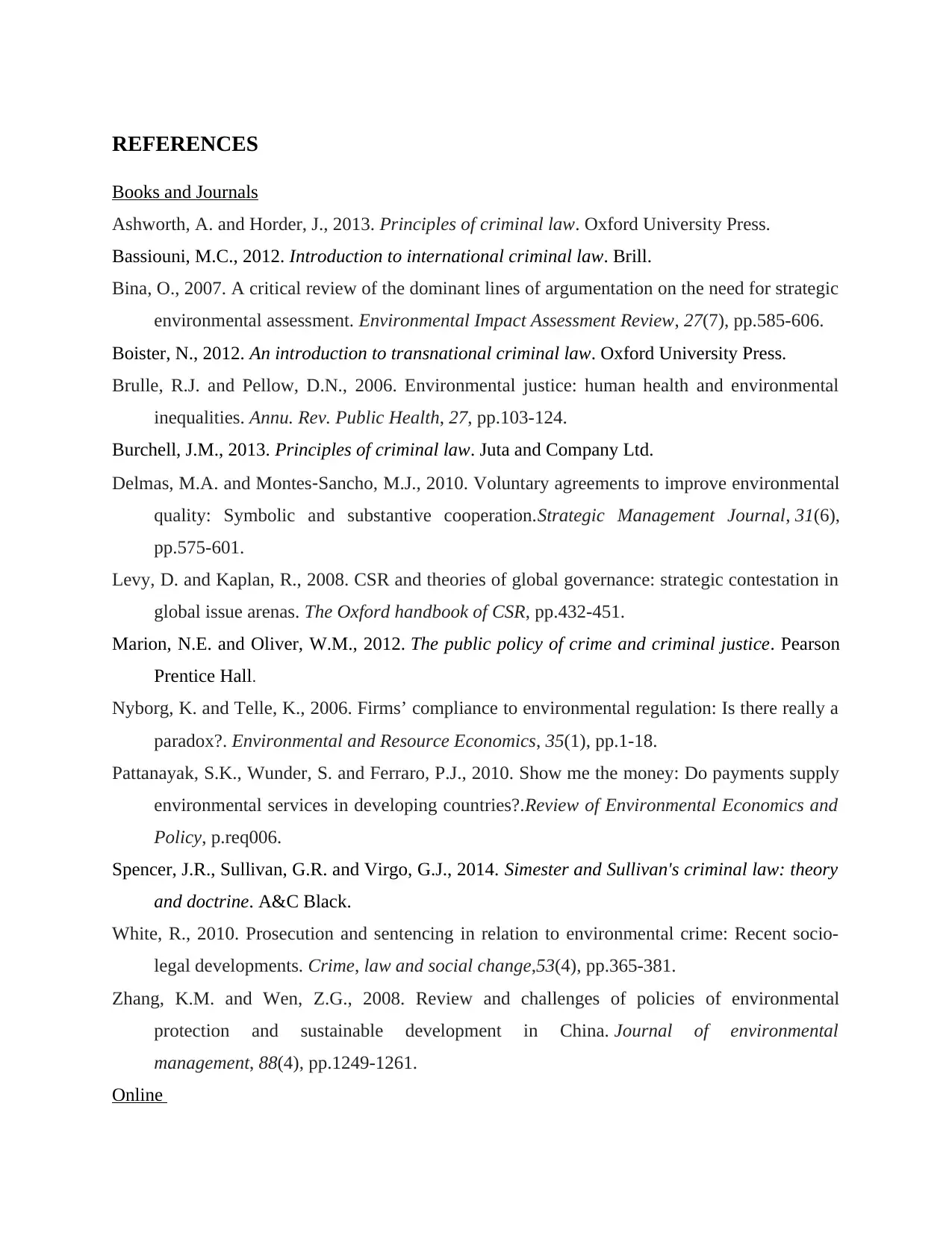
REFERENCES
Books and Journals
Ashworth, A. and Horder, J., 2013. Principles of criminal law. Oxford University Press.
Bassiouni, M.C., 2012. Introduction to international criminal law. Brill.
Bina, O., 2007. A critical review of the dominant lines of argumentation on the need for strategic
environmental assessment. Environmental Impact Assessment Review, 27(7), pp.585-606.
Boister, N., 2012. An introduction to transnational criminal law. Oxford University Press.
Brulle, R.J. and Pellow, D.N., 2006. Environmental justice: human health and environmental
inequalities. Annu. Rev. Public Health, 27, pp.103-124.
Burchell, J.M., 2013. Principles of criminal law. Juta and Company Ltd.
Delmas, M.A. and Montes‐Sancho, M.J., 2010. Voluntary agreements to improve environmental
quality: Symbolic and substantive cooperation.Strategic Management Journal, 31(6),
pp.575-601.
Levy, D. and Kaplan, R., 2008. CSR and theories of global governance: strategic contestation in
global issue arenas. The Oxford handbook of CSR, pp.432-451.
Marion, N.E. and Oliver, W.M., 2012. The public policy of crime and criminal justice. Pearson
Prentice Hall.
Nyborg, K. and Telle, K., 2006. Firms’ compliance to environmental regulation: Is there really a
paradox?. Environmental and Resource Economics, 35(1), pp.1-18.
Pattanayak, S.K., Wunder, S. and Ferraro, P.J., 2010. Show me the money: Do payments supply
environmental services in developing countries?.Review of Environmental Economics and
Policy, p.req006.
Spencer, J.R., Sullivan, G.R. and Virgo, G.J., 2014. Simester and Sullivan's criminal law: theory
and doctrine. A&C Black.
White, R., 2010. Prosecution and sentencing in relation to environmental crime: Recent socio-
legal developments. Crime, law and social change,53(4), pp.365-381.
Zhang, K.M. and Wen, Z.G., 2008. Review and challenges of policies of environmental
protection and sustainable development in China. Journal of environmental
management, 88(4), pp.1249-1261.
Online
Books and Journals
Ashworth, A. and Horder, J., 2013. Principles of criminal law. Oxford University Press.
Bassiouni, M.C., 2012. Introduction to international criminal law. Brill.
Bina, O., 2007. A critical review of the dominant lines of argumentation on the need for strategic
environmental assessment. Environmental Impact Assessment Review, 27(7), pp.585-606.
Boister, N., 2012. An introduction to transnational criminal law. Oxford University Press.
Brulle, R.J. and Pellow, D.N., 2006. Environmental justice: human health and environmental
inequalities. Annu. Rev. Public Health, 27, pp.103-124.
Burchell, J.M., 2013. Principles of criminal law. Juta and Company Ltd.
Delmas, M.A. and Montes‐Sancho, M.J., 2010. Voluntary agreements to improve environmental
quality: Symbolic and substantive cooperation.Strategic Management Journal, 31(6),
pp.575-601.
Levy, D. and Kaplan, R., 2008. CSR and theories of global governance: strategic contestation in
global issue arenas. The Oxford handbook of CSR, pp.432-451.
Marion, N.E. and Oliver, W.M., 2012. The public policy of crime and criminal justice. Pearson
Prentice Hall.
Nyborg, K. and Telle, K., 2006. Firms’ compliance to environmental regulation: Is there really a
paradox?. Environmental and Resource Economics, 35(1), pp.1-18.
Pattanayak, S.K., Wunder, S. and Ferraro, P.J., 2010. Show me the money: Do payments supply
environmental services in developing countries?.Review of Environmental Economics and
Policy, p.req006.
Spencer, J.R., Sullivan, G.R. and Virgo, G.J., 2014. Simester and Sullivan's criminal law: theory
and doctrine. A&C Black.
White, R., 2010. Prosecution and sentencing in relation to environmental crime: Recent socio-
legal developments. Crime, law and social change,53(4), pp.365-381.
Zhang, K.M. and Wen, Z.G., 2008. Review and challenges of policies of environmental
protection and sustainable development in China. Journal of environmental
management, 88(4), pp.1249-1261.
Online
⊘ This is a preview!⊘
Do you want full access?
Subscribe today to unlock all pages.

Trusted by 1+ million students worldwide
1 out of 13
Related Documents
Your All-in-One AI-Powered Toolkit for Academic Success.
+13062052269
info@desklib.com
Available 24*7 on WhatsApp / Email
![[object Object]](/_next/static/media/star-bottom.7253800d.svg)
Unlock your academic potential
Copyright © 2020–2025 A2Z Services. All Rights Reserved. Developed and managed by ZUCOL.





